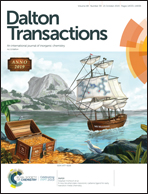Two is better than one: difunctional high-affinity PSMA probes based on a [CpM(CO)3] (M = Re/99mTc) scaffold†
Abstract
More than 10% of all men will be given the diagnosis “prostate cancer” during their lifetime. Most of the current radio-diagnostic vehicles involve both expensive and localized production with cyclotrons as well as the use of bulky chelators for the radiometal. We report the use of a new multifunctional cyclopentadiene (Cp) platform to prepare difunctional and monofunctional, PSMA-targeting rhenium and technetium-99m complexes. The Cp-complexes and the free ligands are prepared by straightforward functionalization with either one or two Lys-urea-Glu (LuG) PSMA binding motifs. Cell binding assays revealed that the difunctional rhenium complex displays a dissociation constant (KD = 2.1 nM) that is an order of magnitude lower than the monofunctional compound (KD = 24.2 nM). The 99mTc complexes can be prepared in one step and ≤15 min in high yields. These difunctional Cp-Re(I)/99mTc(I) complexes represent a new class of imaging agents with binding affinities comparable to clinically evaluated compounds. Additionally, this study demonstrates that the Cp-platform can readily be derivatized with amine-containing biomolecules. Extending this work to incorporate both targeting and therapeutic moieties could lead to theranostic systems with Re/99mTc.
![Graphical abstract: Two is better than one: difunctional high-affinity PSMA probes based on a [CpM(CO)3] (M = Re/99mTc) scaffold](/en/Image/Get?imageInfo.ImageType=GA&imageInfo.ImageIdentifier.ManuscriptID=C9DT02506E&imageInfo.ImageIdentifier.Year=2019)


 Please wait while we load your content...
Please wait while we load your content...